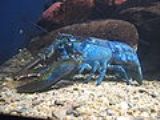
Mutant
Encyclopedia

Biology
Biology is a natural science concerned with the study of life and living organisms, including their structure, function, growth, origin, evolution, distribution, and taxonomy. Biology is a vast subject containing many subdivisions, topics, and disciplines...
and especially genetics
Genetics
Genetics , a discipline of biology, is the science of genes, heredity, and variation in living organisms....
, a mutant is an individual, organism, or new genetic character, arising or resulting from an instance of mutation
Mutation
In molecular biology and genetics, mutations are changes in a genomic sequence: the DNA sequence of a cell's genome or the DNA or RNA sequence of a virus. They can be defined as sudden and spontaneous changes in the cell. Mutations are caused by radiation, viruses, transposons and mutagenic...
, which is a base-pair sequence change within the DNA
DNA
Deoxyribonucleic acid is a nucleic acid that contains the genetic instructions used in the development and functioning of all known living organisms . The DNA segments that carry this genetic information are called genes, but other DNA sequences have structural purposes, or are involved in...
of a gene
Gene
A gene is a molecular unit of heredity of a living organism. It is a name given to some stretches of DNA and RNA that code for a type of protein or for an RNA chain that has a function in the organism. Living beings depend on genes, as they specify all proteins and functional RNA chains...
or chromosome
Chromosome
A chromosome is an organized structure of DNA and protein found in cells. It is a single piece of coiled DNA containing many genes, regulatory elements and other nucleotide sequences. Chromosomes also contain DNA-bound proteins, which serve to package the DNA and control its functions.Chromosomes...
of an organism resulting in the creation of a new character or trait not found in the wild type
Wild type
Wild type refers to the phenotype of the typical form of a species as it occurs in nature. Originally, the wild type was conceptualized as a product of the standard, "normal" allele at a locus, in contrast to that produced by a non-standard, "mutant" allele...
. The natural occurrence of genetic mutations is integral to the process of evolution
Evolution
Evolution is any change across successive generations in the heritable characteristics of biological populations. Evolutionary processes give rise to diversity at every level of biological organisation, including species, individual organisms and molecules such as DNA and proteins.Life on Earth...
. The study of mutants is an integral part of biology, by understanding the effect that a mutation in a gene has it is possible to establish the normal function of that gene.
In some organisms mutants can be created by gene targeting
Gene targeting
Gene targeting is a genetic technique that uses homologous recombination to change an endogenous gene. The method can be used to delete a gene, remove exons, add a gene, and introduce point mutations. Gene targeting can be permanent or conditional...
to assess the function of any given gene. This experimental approach is called reverse genetics
Reverse genetics
Reverse genetics is an approach to discovering the function of a gene by analyzing the phenotypic effects of specific gene sequences obtained by DNA sequencing. This investigative process proceeds in the opposite direction of so-called forward genetic screens of classical genetics...
.
For example, a collection of knockout moss mutants can be used to identify genes with so far unknown functions .
Etymology
Although not all mutations have a noticeable phenotypic effect, the common usage of the word mutant is generally a pejorativePejorative
Pejoratives , including name slurs, are words or grammatical forms that connote negativity and express contempt or distaste. A term can be regarded as pejorative in some social groups but not in others, e.g., hacker is a term used for computer criminals as well as quick and clever computer experts...
term only used for noticeable mutations. The scientific usage is broader, referring to any organism differing from the wild type.
Mutants should not be confused with organisms born with developmental abnormalities, which are caused by errors during morphogenesis
Morphogenesis
Morphogenesis , is the biological process that causes an organism to develop its shape...
. In a developmental abnormality, the DNA of the organism is unchanged and the abnormality cannot be passed on to progeny. Conjoined twins
Conjoined twins
Conjoined twins are identical twins whose bodies are joined in utero. A rare phenomenon, the occurrence is estimated to range from 1 in 50,000 births to 1 in 100,000 births, with a somewhat higher incidence in Southwest Asia and Africa. Approximately half are stillborn, and a smaller fraction of...
are the result of developmental abnormalities.
Chemicals that cause developmental abnormalities are called teratogens; these may also cause mutations, but their effect on development is not related to mutations. Chemicals that induce mutations are called mutagen
Mutagen
In genetics, a mutagen is a physical or chemical agent that changes the genetic material, usually DNA, of an organism and thus increases the frequency of mutations above the natural background level. As many mutations cause cancer, mutagens are therefore also likely to be carcinogens...
s. Most mutagens are also considered to be carcinogen
Carcinogen
A carcinogen is any substance, radionuclide, or radiation that is an agent directly involved in causing cancer. This may be due to the ability to damage the genome or to the disruption of cellular metabolic processes...
s.

